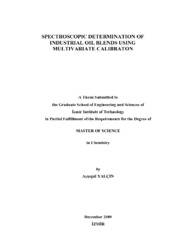Please use this identifier to cite or link to this item:
https://hdl.handle.net/11147/3019Full metadata record
| DC Field | Value | Language |
|---|---|---|
| dc.contributor.advisor | Özdemir, Durmuş | - |
| dc.contributor.author | Yalçın, Ayşegül | - |
| dc.date.accessioned | 2014-07-22T13:50:43Z | - |
| dc.date.available | 2014-07-22T13:50:43Z | - |
| dc.date.issued | 2009 | - |
| dc.identifier.uri | http://hdl.handle.net/11147/3019 | - |
| dc.description | Thesis (Master)--İzmir Institute of Technology, Chemistry, İzmir, 2009 | en_US |
| dc.description | Includes bibliographical references (leaves: 104-106) | en_US |
| dc.description | Text in English; Abstract: Turkish and English | en_US |
| dc.description | xv, 106 leaves | en_US |
| dc.description.abstract | This study focuses on the development of multivariate calibration models for the aluminum rolling oil additives and contaminants using Fourier Transform Infrared (FTIR) spectroscopy and a genetic algorithm based inverse least squares (GILS) method. Multivariate calibration models were generated for both synthetic mixtures and real process samples taken from an industrial aluminum production plant. Two different additives and six different suspected contaminants were investigated in the base oil lubricant. Gas chromatography (GC) was used for the analysis of real process samples in order to establish reference values of additives and contaminants in the base rolling oil. FTIR spectra of real samples together with the reference values established with GC analysis were used to generate multivariate calibration models. GC analysis revealed that most of the contaminants gave overlapped chromatograms and therefore only the total contamination was determined with reference GC analysis. On the other hand, FTIR spectroscopy coupled with multivariate calibration was able to resolve overlapping components with synthetic samples. The reference values for both additives and contaminants obtained by GC were compared with the results of the spectroscopic analysis. The multivariate calibration models based on spectroscopic data validated with the real process samples in a period of twelve months, however only a set of 3-month data is given in this thesis. The R2 values between GC and multivariate spectroscopic determinations were around 0.99 indicating a good correlation between the two methods. | en_US |
| dc.language.iso | en | en_US |
| dc.publisher | Izmir Institute of Technology | en_US |
| dc.rights | info:eu-repo/semantics/openAccess | en_US |
| dc.subject.lcc | TP685 .Y16 2009 | en |
| dc.subject.lcsh | Mineral oils--Analysis | en |
| dc.subject.lcsh | Infrared spektroscopy | en |
| dc.subject.lcsh | Gas chromatography | en |
| dc.subject.lcsh | Calibration | en |
| dc.title | Spectroscopic Determination of Industrial Oil Blends Using Multivariate Calibraton | en_US |
| dc.type | Master Thesis | en_US |
| dc.institutionauthor | Yalçın, Ayşegül | - |
| dc.department | Thesis (Master)--İzmir Institute of Technology, Chemistry | en_US |
| dc.relation.publicationcategory | Tez | en_US |
| dc.identifier.wosquality | N/A | - |
| dc.identifier.scopusquality | N/A | - |
| item.languageiso639-1 | en | - |
| item.openairecristype | http://purl.org/coar/resource_type/c_18cf | - |
| item.fulltext | With Fulltext | - |
| item.cerifentitytype | Publications | - |
| item.openairetype | Master Thesis | - |
| item.grantfulltext | open | - |
| Appears in Collections: | Master Degree / Yüksek Lisans Tezleri | |
Files in This Item:
| File | Description | Size | Format | |
|---|---|---|---|---|
| T000229.pdf | MasterThesis | 7.73 MB | Adobe PDF |  View/Open |
CORE Recommender
Page view(s)
182
checked on Jun 2, 2025
Download(s)
134
checked on Jun 2, 2025
Google ScholarTM
Check
Items in GCRIS Repository are protected by copyright, with all rights reserved, unless otherwise indicated.